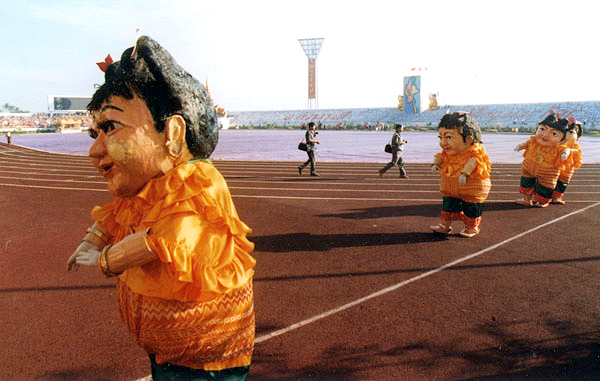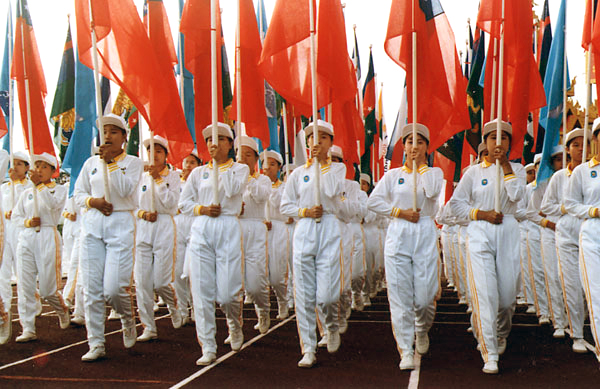Visit Myanmar—That’s an Order
By Stephen Brookes • World Hum • September 9, 2008
T
seven-foot dolls had taken their papier-mâché heads off and were milling around behind the stadium, smoking cigarettes and chatting up the dancing girls from the Ministry of Culture.
You could hardly blame them—the enormous heads were hot and airless, and the guys inside had to peer out from two little eyeholes cut into the mouth. Besides, the dancing girls were cute and had jasmine flowers in their hair, and they weren’t due in the stadium for another 15 minutes, to do their part—along with more than 5,000 other costumed performers—for a massive ceremony to usher in “Visit Myanmar Year.”
It was November 18, 1996, and at 5:30 that morning, Myanmar’s military junta had rounded up the few foreign journalists in town and bussed us to a stadium just outside Rangoon, for what they promised would be the media event of the year. Now, two hours later, most of us had managed to sneak out of our assigned seats and were wandering around on the field, trying to figure out what was going on. I stumbled into a makeshift staging area, where I found the gigantic papier-mâché dolls. One of them offered me a Marlboro.
“What are you, exactly?” I asked him. His head looked ridiculously tiny, poking out of the huge wire-and-cardboard body that hung on his shoulders with a pair of straps. His little white-gloved hands dangled comically at the end of enormous arms, and his costume was a lurid cascade of gold ruffles. On the ground beside him sat his huge head. It was difficult to look at him for very long.
“We’re pageboys,” he told me, as a uniformed marching band filed past. “Back in the time of kings, you know, pageboys would serve the king. Carry messages. Serve tea.”
The dancing girls had danced away to a safe distance, but a crowd of small boys—also dressed up as pageboys but normal-sized—had moved in to see what was going on. There were hundreds of them, all dressed in identical crimson-and-gold costumes, all wearing black polyester wigs tied in two pigtails, all made up disturbingly in bright red lipstick, pink eye shadow and yellow face powder. They were difficult to look at, too.
A nervous-looking woman noticed me, then barked something at the boys and began clapping. The boys began to leap rhythmically up and down, pointing with their index fingers in various directions and grinning like miniature maniacs.
“That’s the pageboy dance,” explained the big doll. “The pageboys would walk ahead of the king and tell people where to go. ‘Go this way! Go that way!’” He stuck his fingers in the air and wagged them like the boys were doing, to show me what he meant. The woman barked again, and the pageboys stopped jumping.
“Impressive,” I said. “How many of them are there?” He looked around at the sea of faces that surrounded us and took a drag on his cigarette.
“About five hundred,” he said, exhaling a long stream of smoke.
Out in the stadium, meanwhile, the ceremony was getting ready to start. From a huge gate at one corner, a marching band burst onto the field playing the national anthem, and from another gate, a battalion of uniformed flag-bearers entered. As they marched around the field in perfect precision, an announcement burst out of the loudspeakers and everyone looked up into the sky. Far above us, a team of parachutists was descending, unfurling a gigantic “Visit Myanmar” banner as they fell. At the moment they hit the ground, the entire audience on the far side of the stadium stood up holding colored cards that spelled out in huge letters, “Enjoy Your Stay in Myanmar.”
Next to me, a Japanese journalist was staring wide-eyed at the spectacle, shaking his head as he searched for the right word. “It’s so ... so ... North Korean,” he said, finally.
 The rest of the event came off with, as you’d expect, tight military precision. As a helicopter circled lazily above the stadium and the TV Myanmar film crews beamed footage back for the live broadcast, the Minister for Tourism extolled the joys and natural beauty of the country, adding that the tourism campaign should convince any doubters about “our commitment to open our doors to the world.”
The rest of the event came off with, as you’d expect, tight military precision. As a helicopter circled lazily above the stadium and the TV Myanmar film crews beamed footage back for the live broadcast, the Minister for Tourism extolled the joys and natural beauty of the country, adding that the tourism campaign should convince any doubters about “our commitment to open our doors to the world.”
Then there were floats made up as white, winged elephants; flying wedges of pom-pom girls; and troupes of dancing girls who swayed vaguely back and forth to Burmese pop tunes. And, of course, the 10 giant pageboy dolls I’d seen earlier that morning came out and lumbered their way around the stadium, waving blindly at the audience and trying not to knock each other down.
But as the ceremony wore on, one of the photographers noticed something odd. Almost the entire audience seemed to be divided into groups of women dressed in the same bright distinctive colors. Not only that: Each section would periodically empty out and suddenly reappear on the stadium field—as dancers.
“Too much!” the photographer said, when it dawned on us what was happening. “They’re performing for themselves!”
It was true—and it explained the listless, vacant quality of the applause; they’d all seen everything before, in rehearsal. And as we scanned the viewing stands, with their bored enclaves of military officials, diplomats, travel agents and hotel managers, we realized that, for the Grand Opening of Visit Myanmar Year, there were only about 30 actual tourists—bussed in unknowingly, we found out later, as part of a group that happened to be in Rangoon that day.
After the closing song ("We sing of our modern developed country, and we welcome all visitors to this wondrous golden land"), I joined the mass exodus, got a useless quote from the Minister for Tourism ("We had a very good opening to Visit Myanmar Year!") and bumped into Sue Reitz, the smart, sardonic manager of the Strand Hotel.
“Enjoy your stay in Myanmar, Sue,” I urged her, as we walked out into the parking lot.
“Thank you, Stephen, I will,” she replied, with a thin smile. “But then—we don’t really have much choice in the matter, do we?”
References (4)
-
 Response: perlengkapan marchingband
Response: perlengkapan marchingband -
 Response: Buffet Quotes Kilmarnock
Response: Buffet Quotes Kilmarnock -
 Response: Hivemind Lyrics - The BrowningHivemind ѕіngulаritу Hivemind it's tоo latе Hivemind humanity will Вow down
Response: Hivemind Lyrics - The BrowningHivemind ѕіngulаritу Hivemind it's tоo latе Hivemind humanity will Вow down -
 Response: Calgary baby photographerDiscover stunning photography by Maxine LaGarde, a talented Calgary photographer. Explore images and book to capture unforgettable moments.
Response: Calgary baby photographerDiscover stunning photography by Maxine LaGarde, a talented Calgary photographer. Explore images and book to capture unforgettable moments.


Reader Comments